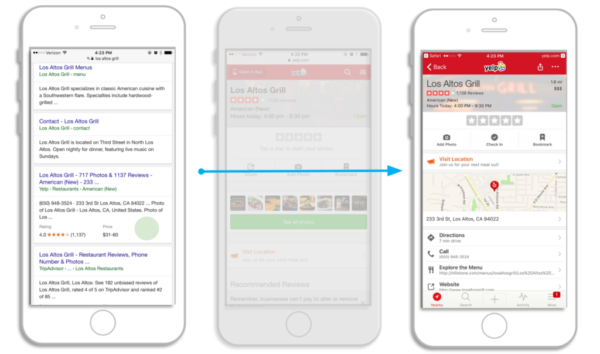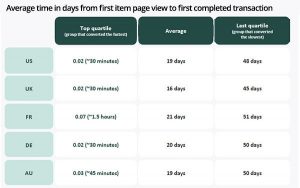— June 16, 2019
People spent an average of 3 hours and 15 minutes on their mobile phones in 2018. The heavier of users even went over 4 hours glued to their devices. Mobile is steadily taking over as the medium of choice for entertainment and is at pace to eclipse traditional media like TV.
As the market shifts, more companies are now forced to shore up their mobile presence. This has only upped the competition in the mobile space. Users can now find an app for just about anything and it isn’t uncommon to have hundreds of apps performing that same functions. For your mobile strategy to succeed, you have to offer something superior to what your competitors offer.
In parallel, the number of searches conducted from mobile devices have exceeded those made from desktops and laptops. Google’s official figures put the share of mobile searches at 60% (amounting to more than 50 billion in number). And here’s an industry-wise breakdown of that share:

At the same time, app developers are having an increasingly hard time getting people to install (and use) their apps. Even if some of your content that can be best viewed on your mobile app is visible and discoverable via organic search, installing the app just to view the content is a huge leap that few users are willing to take.
If you’re a company with an app, you must optimize visitors’ mobile experience and effectively employ techniques like “deep linking” to serve targeted content to users, creating more frictionless experiences. Apple’s Universal Links and Android App Links allow for a seamless transition from web search to content in the app, by opening up the corresponding screen within the app when a user clicks on a search result, provided they’ve installed the app on their phone.
To the uninitiated, deep linking sounds like some obscure practice that’s best left to those with a higher tech quotient. However, with Google rolling out its “mobile-first” index, all businesses need to sit up and take notice right now, if they haven’t already.
So what exactly are deep links and how do they relate to your mobile strategy?
What Are Deep Links?
To get a grasp of what deep links are, you must first understand the concept of a link. If you’re viewing this article on a browser, simply look at the address bar and you’d see this page’s address or universal resource locator (URL). It directs users to an exact location of this particular content on the internet. Other web pages can use this link to this URL in their content so that when a user clicks on the link, they will be sent directly to this page.
A link such as https://www.facebook.com/business2community can be broken down as follows:
- https:// – The protocol
- www – The subdomain
- facebook – The domain name
- com – The top level domain
- business2community – The path
Any link that points to a path or any page “deeper” than the home page (in this case: http://www.facebook.com) is technically a deep link. Deep links are typically used to point users to specific content. Retailers, for example, may use deep links in marketing emails or ad banners to drive users to particular product pages.
How Do They Work on Mobile?
It’s a bit rare to hear about deep links as a term used in the context of webpages. Links on web browsers are pretty straightforward — when a link is clicked, the browser goes straight to the linked page. These days, the deep links are more often encountered in discussions surrounding mobile. Partly, it’s because links work a bit differently in mobile.
When you click a deep link on a mobile browser, what happens next depends on the specific configuration of the device and the apps available on it. If the website doesn’t have an associated app, clicking a deep link might simply open the page on the browser. If it does have an app, the deep link might launch the app and open the specific content within it.
However, for this to happen, apps have to be properly configured to handle deep links. The process is unique for Android and iOS, so developers have to factor these in the app’s design. Yelp is a company that does this well:

There may also be instances when a user hasn’t installed the relevant app yet. If properly configured, the deep link will open the app’s App Store page and prompt the user to install the app first. If deferred deep linking is used, the specific content will open within the app as soon as it is installed.
What Advantages Do They Bring?
The key idea behind deep links in mobile is that they help facilitate the flow of a user’s content consumption or transaction from one step to the next. Deep links are particularly useful in creating more integrated user experiences.
For instance, a retail company might send a user an email about its latest sale. The user reads the message in the app’s email app. The user gets interested in a particular product and clicks on the deep link within the email. If deep links are properly set, the user would automatically be sent to the ecommerce app and directly to the specific product’s page.
Through these seamless transitions, users are likely to proceed with their purchase. If such configurations aren’t properly set for the app, companies may stand to lose out on potential conversions as the flow essentially breaks down.
Other benefits include
- personalized screens that pick up from their previous browsing points
- more engagement and usage
- better tracking and attribution
- additional channel for marketing and remarketing
- faster navigation to desired customer action
- better context to nudge conversions
- prevention of installation fraud
Why Should You Care?
Deep linking in mobile is something all companies with a mobile presence should consider. To start with, it provides a frictionless experience for the user. This is essential for companies that have complex funnels involving customer stories, such as the ecommerce and travel niches. Using deep links, you can chain together touchpoints and usher users towards their desired ends.
Fortunately for businesses, deep linking in mobile is often available packaged with mobile attribution services, as the technology that underpins both are the same. So if you’re already implementing analytics using mobile attribution, chances are you can hit two birds with one stone. By combining both, you could create analytics-driven campaigns that effectively utilize channels like web app banners, emails, social media, SMS, and even QR codes to achieve optimal conversion.
Over to You
Considering how critical it is to capture and sustain users’ interest for mobile success, companies must be able to leverage available means to improve engagement. Deep linking is one of the clear ways you can achieve this. The implementation of deep links is complex, but once you get it right, the advantages will more than compensate for the resources invested.
Digital & Social Articles on Business 2 Community
(77)
Report Post






